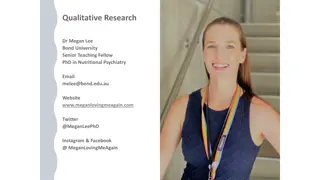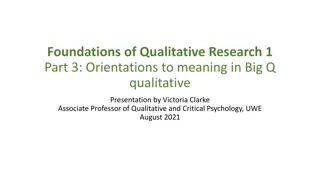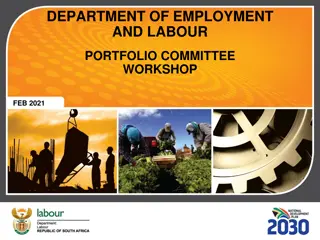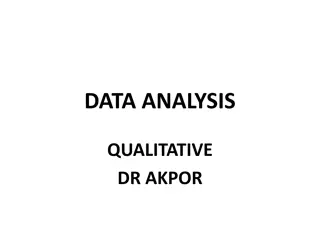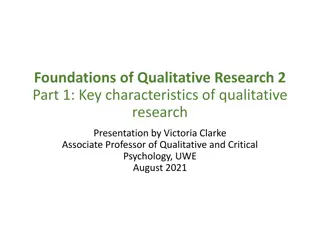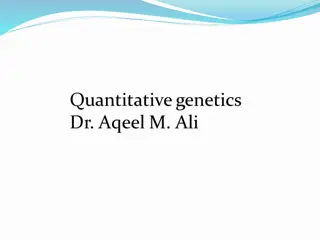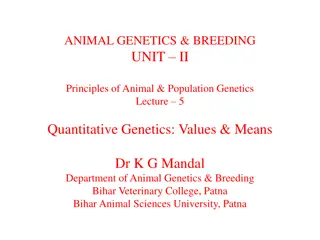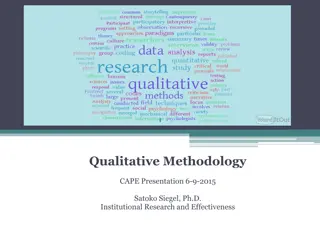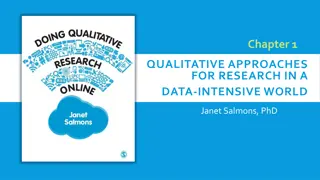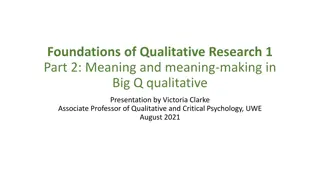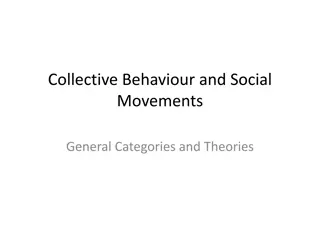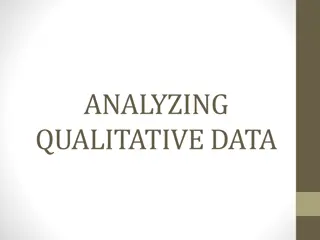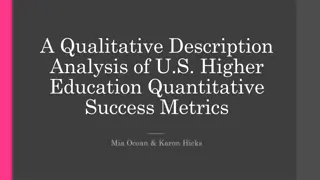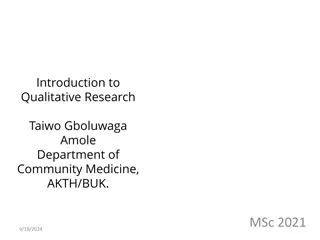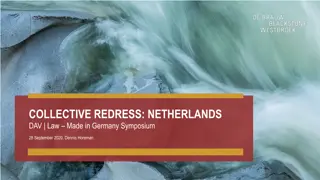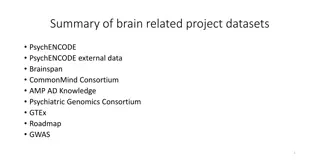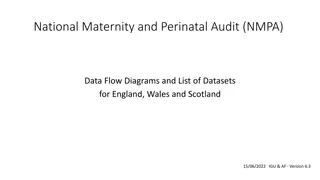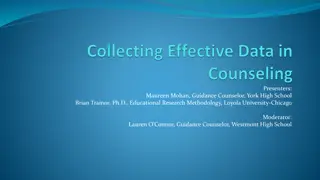Strategies for Collective Qualitative Secondary Analysis Using Combined Datasets
Collective qualitative secondary analysis involves reusing data through a collaborative lens, embracing multiple viewpoints to gain deeper insights. The approach emphasizes the constructed nature of research data and allows for diverse interpretations and engagements. This article discusses the process of combining datasets, conducting qualitative secondary analysis, and the value of collaborative workshops in analyzing data collectively.
Uploaded on Sep 16, 2024 | 1 Views
Download Presentation

Please find below an Image/Link to download the presentation.
The content on the website is provided AS IS for your information and personal use only. It may not be sold, licensed, or shared on other websites without obtaining consent from the author. Download presentation by click this link. If you encounter any issues during the download, it is possible that the publisher has removed the file from their server.
E N D
Presentation Transcript
Strategies for collective qualitative secondary analysis using combined datasets Dr Anna Tarrant, University of Lincoln Dr Kahryn Hughes, University of Leeds atarrant@lincoln.ac.uk
Starting point: data re-use There is no a-priori privileged moment in time in which we can gain a deeper, more profound, truer insight, than in any other moment .There is never a single authorised reading...It is the multiple viewpoints, taken together, which are the most illuminating (Brockmeier & Resissman cited in Andrew, 2008: 89-90). Our starting point is the position that research data, including qualitative longitudinal research data, are not simply out there but are inevitably constructed and re-constructed in different social, spatial and historical contexts (Neale, 2018) They have value and integrity in different contexts and moments Sources become capable of more than one interpretation, and their meaning and salience are produced through different modes of research engagement Whether revisiting own data later or allowing others to use it, this has little bearing on the interpretive process
Timescapes and QSA QSA of two existing datasets conducted to set up Men, Poverty and Lifetimes of Care study (Tarrant, 2016) Bringing together two existing QL datasets - Intergenerational Exchange (IGE) and Following Young Fathers (FYF) Early superficial similarities identified: Both conducted in same UK city, both samples included people living in similar places and conditions Early analytic work (two collective analysis workshops) provided sufficient evidence to support further QSA to explore degree of linkage and complementarity of men in low income contexts.
The workshops Data sampled theoretically by the data originators, Typical and atypical cases Bringing datasets into meaningful analytic conversation (Irwin and Winterton, 2011a, b), Our observations: We engaged in a process whereby we added data to an analytical pot , Participants didn t always necessarily agree with one another but they were: Synthesising findings from their research with data from other people s, Reformulating their ideas and understandings in light of new questions, Refining their ideas rather than having their ideas subsumed by others, The new questions were a form of recontextualisation
Workshops and sampling We were able to: Test/explore the extent, identity and differences of the sample, Describe the datasets theoretically, Develop emblematic cases these are not necessarily thematic, but more theoretical, or based on content, and questions of socio demographics of participants, Explore and identify outliers, anomalies, antithetical and different cases in both the seen and unseen data,
Linkage and complementarity 1) Shared geographic contexts - Socio-economic and geographical contexts materially similar with regards to life expectancy, high prevalence of teenage births, high rates of miscarriage and neo-natal deaths (Emmel and Hughes, 2010) 2) Thematic/ substantive - Persistence of poverty over the lifecourse, - little room for change and diversity in low income circumstances, - limited scope for alternative lifecourse trajectories - Importance of support services in providing crucial resources 3) Theoretical: Shared orientation towards questions of time - Biographical, generational and historical (Neale, 2012)
Key questions Methodological questions: 1) how far can these qualitative findings be cumulative beyond the lifetime of the original research? 1) how far does QSA enable us to broaden the empirical field of enquiry? Subsequent substantive questions (Tarrant and Hughes, forthcoming): 1) In bringing these two datasets together, can we build an intergenerational sample of men in low income contexts to further our understanding of their generational identities and intergenerational experiences? 1) What sorts of intergenerational and intragenerational analyses are possible?
Emblematic cases: Will (IGE) and Karl (FYF) Will, age 14 Described from the perspective of his grandmother Will became a young father (unplanned) just after he turned 14 Will is still at school and ha contact with the mother of his child, although they are not in a relationship, Will s access to his child is being contested by the maternal grandmother Karl, age 16 Has an unplanned baby Not in a relationship with the mother of the child, Expected to attend supervised contact with his son at times that are incompatible with his college course requirements, He describes how the baby is take into care when the mother fails a care assessment,
Analysis of emblematic cases Complementarity of cases: Both are off time fathers and ostensibly occupy the same generational position, Both require significant intervention and support from family members and services to be there for their children, The familial and biographical timescapes of Karl and Will do not mesh with institutional timescapes of statutory services and education, Both cases confirm that where services focus on a particular individual, in a particular generational position, other possible generational positions are obscured (i.e. focus on parent generation rather than child), Slight age differences becomes meaningful Karl (age 16) as a prospective case for Will (age 14)?
Victor (IGE) and Jason (FYF) Can we build an intergenerational sample? Victor, age 44 Re-partnered father with a son from a previous relationship, Married to Carolyn who has four children and a grandson, for whom they engage as informal kinship carers across data sweeps, Generational identities include; absent father, young dad, step- father, step-grandfather and foster parent Jason, 20 years Has a son but is in an on/off relationship with the mother of his child, Has an absent father who has re-partnered several times,
Analysis We asked whether Victor could be a proxy for Jason s dad as an absent father, and provide an intergenerational case to sit alongside Jason s dads experiences of being absent or present through Jason s account, Could Victor be a future case for Will, Karl or Jason? No - not enough data to do this kind of work in either dataset because of focus of each study, Concluded the need for new research with an expanded focus and sample, Similarities between Victor and Jason s dad prompted further consideration of shared generational experience development of intragenerational cohorts from both studies
Intragenerational cohort analysis Lads on the estate the character of young men s caring responsibilities in low income families and contexts Dean, age 24, son of Sheila (IGE) Steve, age 28, son of Sheila (IGE) Describe protective strategies and efforts for their younger brother to stop him getting into trouble with the police
Intragenerational commonalities between IGE and FYF What we were able to observe in bringing datasets together: Volatility in relationships with partners of young children, Insecurity in work and worklessness, Nepotism around securing casual work through family and extended family relationships, Difficulties with maternal grandmothers as gatekeepers to children and other resources such as employment Enduring character of marginalisation and vulnerability
Conclusions Analytical workshops with purposefully assembled researchers an important methodological strategy in bringing existing data together, These supported us to test the possibilities of bringing two different QL datasets together in meaningful analytical conversation (Irwin and Winterton, 2011a, b), Where we engaged in breadth analysis in the workshops, in subsequent work we engaged in more depth analysis to test our questions, Our strategy and endeavors towards theoretical refinement helped us to determine the possibilities and limits of what we were able to achieve, What did we gain? We saw where and when men were able to explicitly intervene in people s lives in their families Galvanised to case further from the data to take this QSA work forward in new and creative ways (Tarrant and Hughes, forthcoming)
References Emmel and Hughes (2010) Recession, it s all the same to us son : The longitudinal experience (1999 2010) of deprivation, Twenty-First Century Society, 5 (2): 171 181. Irwin, S. and Winterton, M. (2011a) Debates in qualitative secondary analysis: Critical reflections, Timescapes Working Paper, Series No. 4. Retrieved from http://www.timescapes. leeds.ac.uk/assets/files/WP4%20March%202011.pdf, [Accessed 25.08.2015] Irwin, S. and Winterton, M. (2011b) Qualitative Secondary analysis: A Guide to Practice, Timescapes Methods Guide Series No. 19. http://www.timescapes.leeds.ac.uk/assets/files/secondary_analysis/working%20papers/WP7- Nov-2011.pdf, [Accessed 25.08.2015] Neale, B. (2012) The Timescapes Archive: A resource for qualitative longitudinal research. Available at: http://www.timescapes.leeds.ac.uk/assets/files/archive/The-Timescapes-Archive- Report.pdf. Tarrant, A. and Hughes, K. (2018) Qualitative Secondary Analysis: Building Longitudinal Samples to Understand Men s Generational Identities in Low Income Contexts, Sociology, 0 (0). Tarrant, A. and Hughes, K. (forthcoming) Precarious Families, Marginalised: Telling Longitudinal Stories of Low-Income Life, London:Palgrave Pivot.









